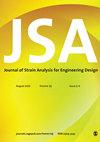Effect of porosity and skew edges on transient response of functionally graded sandwich plates
IF 1.4
4区 工程技术
Q3 ENGINEERING, MECHANICAL
Journal of Strain Analysis for Engineering Design
Pub Date : 2021-12-06
DOI:10.1177/03093247211062694
引用次数: 3
Abstract
This work for the first time presents the effect of porosity and skew edges on the transient response of functionally graded material (FGM) sandwich plates using a layerwise finite element formulation. Two configurations of FGM sandwich plates are considered. In the first configuration, the top and the bottom layers are made of the FGM and the core is made of pure metal, whereas in the second configuration, the bottom, core and the top layers are made of pure metal, FGM and pure ceramic, respectively. Four micromechanics models based on the rule of mixture are used to model porosity for these two configurations of FGM sandwich plates. A layerwise theory based on a first-order shear deformation theory for each layer that maintains the displacement continuity at the layer interface is used for the present investigation. An eight-noded isoparametric element with nine degrees of freedom per node is used to develop the finite element model (FEM). The governing equations for the present investigation are derived using Hamilton’s principle. A wide range of comparison studies are presented to establish the accuracy of the present FEM formulation. It has been shown here that the parameters like skew angle, porosity coefficient, volume fraction index, core to facesheet thickness ratio and boundary conditions have a significant effect on the transient response of FGM sandwich plates. Also, the present finite element formulation is simple and accurate.孔隙率和斜边对功能梯度夹层板瞬态响应的影响
本文首次采用分层有限元方法研究了多孔性和斜边对功能梯度材料(FGM)夹层板瞬态响应的影响。考虑了FGM夹层板的两种结构。在第一种结构中,顶层和底层由FGM制成,核心由纯金属制成,而在第二种结构中,底层、核心和顶层分别由纯金属、FGM和纯陶瓷制成。采用基于混合规律的四种细观力学模型对这两种结构的FGM夹层板的孔隙率进行了模拟。本研究采用基于一阶剪切变形理论的分层理论,保证了各层在层界面处的位移连续性。采用八节点等参单元,每个节点有9个自由度来建立有限元模型。本研究的控制方程是用汉密尔顿原理推导出来的。提出了广泛的比较研究,以确定目前的有限元公式的准确性。结果表明,斜倾角、孔隙系数、体积分数指数、芯板厚度比和边界条件等参数对FGM夹层板的瞬态响应有显著影响。此外,现有的有限元公式简单、准确。
本文章由计算机程序翻译,如有差异,请以英文原文为准。
求助全文
约1分钟内获得全文
求助全文
来源期刊

Journal of Strain Analysis for Engineering Design
工程技术-材料科学:表征与测试
CiteScore
3.50
自引率
6.20%
发文量
25
审稿时长
>12 weeks
期刊介绍:
The Journal of Strain Analysis for Engineering Design provides a forum for work relating to the measurement and analysis of strain that is appropriate to engineering design and practice.
"Since launching in 1965, The Journal of Strain Analysis has been a collegiate effort, dedicated to providing exemplary service to our authors. We welcome contributions related to analytical, experimental, and numerical techniques for the analysis and/or measurement of stress and/or strain, or studies of relevant material properties and failure modes. Our international Editorial Board contains experts in all of these fields and is keen to encourage papers on novel techniques and innovative applications." Professor Eann Patterson - University of Liverpool, UK
This journal is a member of the Committee on Publication Ethics (COPE).
 求助内容:
求助内容: 应助结果提醒方式:
应助结果提醒方式:


